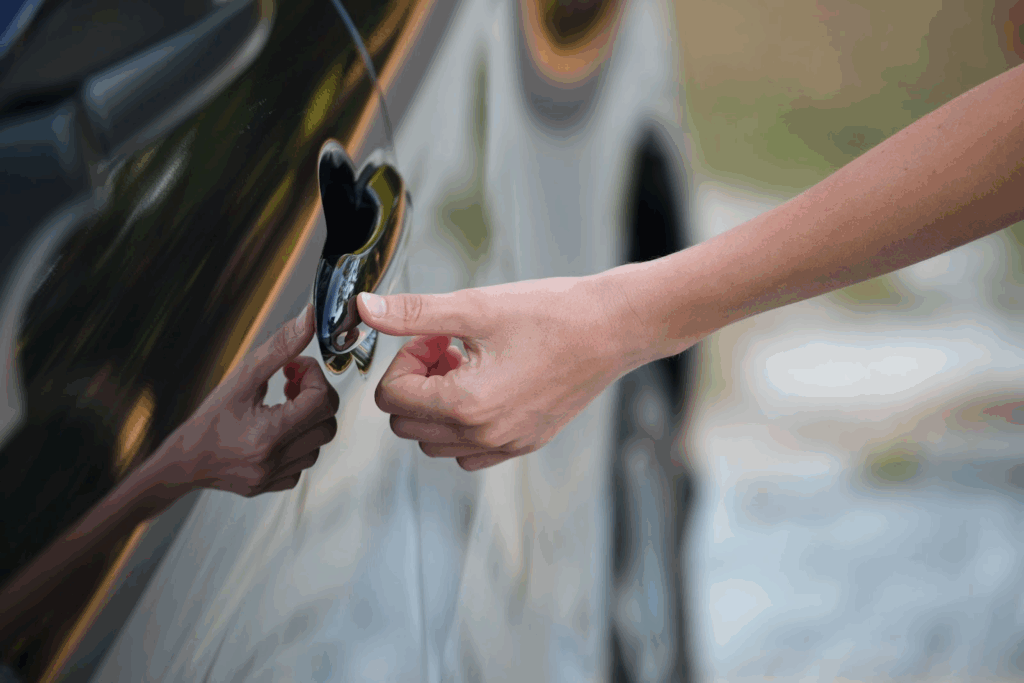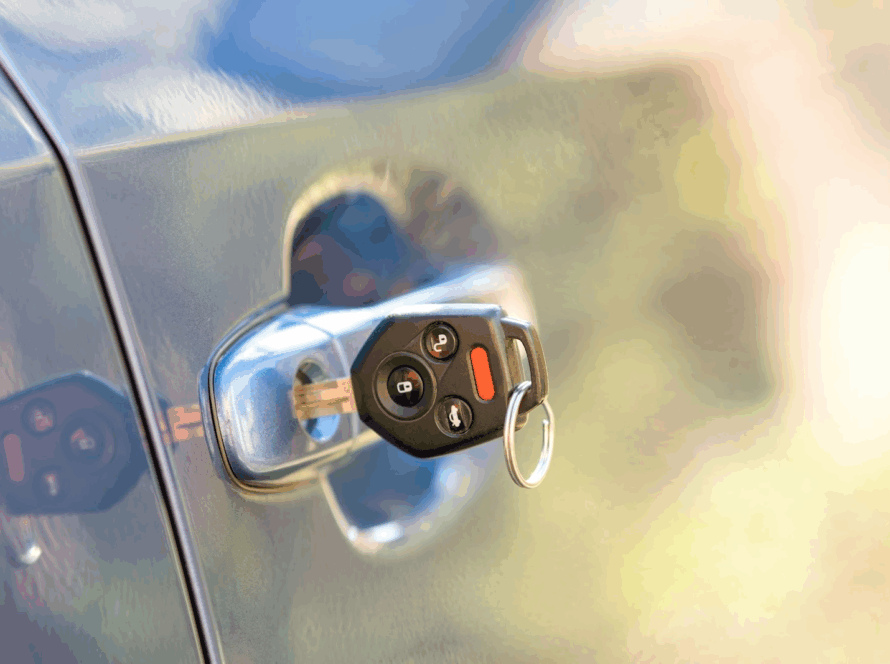A car lockout happens fast—one rushed moment, and you’re standing outside your vehicle, keys still inside. Property owners often attempt DIY fixes to regain access, thinking it’ll be cheaper or quicker than calling a pro. But modern vehicles are built with anti-theft systems, electronic locks, and fragile door components that don’t respond well to homemade tools. One wrong move can leave you with a broken lock, a damaged door, or a system malfunction far more expensive than a locksmith’s fee.
Why DIY Car Lockout Fixes Often Cause More Harm
What starts as a simple car lockout can spiral fast when you try fixing it yourself. Without the right tools or experience, even small actions can damage locks, wiring, or door frames. These attempts often turn a minor delay into a costly repair. Below are the main reasons why handling it alone usually backfires.
Car Lockout Scenarios Depend on the Vehicle
No two vehicles handle lockouts the same way, and that’s what makes DIY methods so unreliable. A 2005 pickup may have a simple lock cylinder, but a 2023 SUV with a keyless entry system uses encrypted signals, tamper alarms, and sensitive wiring. Trying the same DIY trick on both could result in a minor success or a major system failure. Understanding how vehicle locks work and the variations across different brands and models is crucial for avoiding costly mistakes.
Different Cars Require the Right Tools
Each vehicle model has specific internal mechanisms that react differently to pressure, entry angles, and force, making general tools like hangers or rods highly risky. What seems like a gentle nudge can dislodge wires, bend locking rods, or damage side airbags. Certified locksmiths use decoding tools, air wedges, and manufacturer-specific methods to protect the lock while solving the problem. Guesswork with generic tools usually ends in more harm than help.
Keyless Entry Locks Are Not DIY-Compatible
Keyless entry systems use encrypted chips, motion sensors, and digital relays that don’t respond to physical manipulation. That means a shoelace or hanger won’t help and might trigger an anti-theft lockdown. These locks may shut down under suspicious behavior, and interfering with them can permanently lock you or require dealership-level diagnostics. Without the software and gear locksmiths carry, any attempt to force entry risks turning off your car entirely.
Cold Weather Lockouts Add Extra Risk
In cold climates, locks can freeze, and door seals become stiff, making DIY entry attempts even more dangerous to your car’s integrity. Applying hot water or prying at icy doors can lead to cracked plastic, torn rubber seals, or electrical damage from melting ice entering control units. Professional locksmiths carry safe de-icing solutions and non-invasive entry tools that avoid damage, keeping the lock and electronics intact.
DIY Car Lockout Methods Usually Cause Damage
Many standard DIY techniques, like slim jims, wedges, shoelaces, or screwdrivers, are outdated and don’t work on most modern cars. Worse, they cause internal damage. While they may open the door briefly, they often warp internal rods, tear seals, and compromise sensors and electronics, leading to costly repairs later. DIY methods also leave visible signs of tampering that reduce resale value and can complicate insurance claims.
Coat Hangers Scratch and Dislodge Components
Sliding a coat hanger into your door may sound harmless, but it often scratches trim, dislodges interior parts, and cuts into insulation or wiring behind the panel. Once the internal rods or connectors shift, locks can stop responding to the key or remote, requiring complete disassembly and repair. Professional locksmiths use insulated, precision tools that avoid this type of damage altogether.
Shoelace Loops Misalign Door Locks
The shoelace method creates enough tension to dislodge pins and rods, especially on cars with vertical lock posts or internal motorized actuators. What might look like success can leave the lock damaged, stuck, or permanently disengaged, especially after repeated tugs. Locks may later stop responding entirely or jam at the worst time.

Screwdrivers and Wedges Tear Door Seals
Using a screwdriver or pry tool to create a gap between the door and frame often bends the door or rips rubber weather seals designed to block wind and water. It leads to leaks, whistling sounds while driving, and eventually corrosion or mold from trapped moisture. Seal replacements and door realignments can be time-consuming and expensive, turning a $150 lockout solution into a $600 repair job.
DIY Car Lockout Fixes Affect Safety and Value
When a door no longer seals or locks properly due to failed DIY fixes, your car becomes a soft target for break-ins. Weak entry points are easily identifiable for thieves, especially when the vehicle is parked in public or residential areas. A professionally repaired lock keeps your car secure, while a compromised one invites loss.
Vehicle Value Suffers From Tampering Signs
Visible damage to door panels, rubber seals, or lock alignment is often flagged during appraisals and pre-sale inspections, leading to lower offers or buyer hesitation. Carfax reports and maintenance histories may also reveal lock repairs or door work, reducing the vehicle’s long-term value and making it harder to sell at market rate.

Insurers Deny Claims on Owner-Caused Damage
Most standard auto insurance policies do not cover damage caused by the owner during attempted repairs, including broken locks or windows. If you break a part while trying to get back in, you may be on your own financially. Insurance companies often require locksmith documentation to process any lock-related claim, making DIY fixes a liability instead of a solution.
Car Lockout Damage Attracts Theft Risks
When a door no longer seals or locks properly due to failed DIY fixes, your car becomes a soft target for break-ins. Weak entry points are easy for thieves to spot, especially if the vehicle is parked in public or residential lots. A professionally repaired lock keeps your car secure, while a compromised one invites loss.
DIY Lockout Fixes Can Create Safety Hazards
Trying to open your car using sharp tools or force, especially in public, high-traffic, or poorly lit areas, puts you at physical risk. The situation can quickly become dangerous if you’re exposed to speeding cars while trying to pry a door or attempting to break a window. Your focus is on the lock, not your surroundings, precisely when accidents happen.
Roadside Lockouts Are Especially Risky
Attempting to fix a lockout on a busy road exposes you to traffic hazards, stress, and injury risk from tools or glass. One misstep while forcing a door could result in a serious accident or emergency call. Mobile locksmiths are trained for roadside work and arrive equipped to resolve the issue safely and quickly.
Shattering Windows Causes More Problems
Breaking a window seems like a last resort but usually causes more trouble than it solves, including injuries, expensive glass replacement, and a wide-open car vulnerable to theft or weather. The time and cost to clean up, reinstall, and realign the window can far outweigh the cost of a locksmith.
Why Locksmiths Offer Safe, Fast Lockout Help
Hiring a licensed locksmith is the safest, most effective way to handle a car lockout, especially when time, value, and safety matter. Professionals use specialized, vehicle-specific tools to unlock your car without damaging its locks, electronics, or frame. Their service protects your warranty, keeps the car intact, and provides valuable documentation for insurance or resale.
Certified Tools Prevent Long-Term Damage
Locksmiths come prepared with decoding tools, non-invasive wedges, and key analyzers that open vehicles cleanly and precisely without damaging internal components. It protects the door’s sensors, locking mechanism, and seals from damage commonly occurring during DIY attempts.
24/7 Services Make it Convenient
Professional locksmiths offer round-the-clock emergency service and often arrive within 30 minutes, even during holidays or weekends. It eliminates the need for risky fixes or long waits, helping property owners and drivers stay on schedule with minimal disruption.
How Locksmiths Safely Handle a Car Lockout
When a professional locksmith responds to a car lockout, they begin by verifying ownership to ensure the service is legal and secure. They then assess the vehicle’s manual, keyless, or digital lock system to choose the safest entry method. Traditional locks may use air wedges and reach tools for that vehicle type. Smart or keyless systems might use diagnostic tools to send an unlock command without triggering alarms. They avoid damaging wiring, sensors, or weather seals throughout the process. The job is completed quickly, often within minutes, with zero harm to the vehicle. This level of precision and care is why professional locksmiths remain the more intelligent choice over DIY fixes.
Choose the Smarter Fix for Car Lockout Problems
Relying on quick tricks during a lockout leads to damage, delays, or regret. When your time, safety, and vehicle are on the line, a professional locksmith delivers clean results without the risk. The difference isn’t just in tools but in training, precision, and accountability. Skip the stress, skip the second-guessing, and trust someone who can fix the problem without worsening it.
Stay informed, prepared, and one step ahead by visiting the Green Key blog for expert tips on locks, safety, and smarter service calls.



